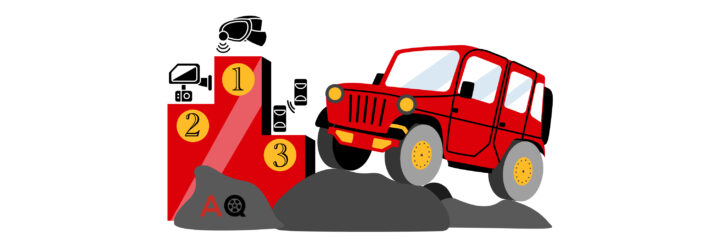No matter how many hours or years you’ve spent behind the wheel and how confident you feel when driving, getting careless can be fatal. Failure to check blind spots leads to many preventable collisions or close calls when turning. There are a few different kinds of devices that help drivers avoid danger in their blind spots and provide extra safety while driving. Here are our top picks for 2025.
- So How Does a Blind Spot Detection System Help?
- What to Look for When Choosing a Blind Spot Detection System
- Top 11 Best Blind Spot Systems 2025
- 1. Best Overall Pick: Audiovox PSD100
- 2. Best Budget Pick: RAAYOO Camera
- 3. Best for Low Speeds: Accele BSS200
- 4. Best Premium Pick: Brandmotion RDBS-1500
- 5. Easiest to Install: Rydeen BSS1 Blind Spot System
- 6. Best Visual Blind Spot System: Natika Backup/Front/Side View Camera
- 7. Best Side Camera: E-KYLIN side camera
- 8. Best Value Blind Spot Detection System: CarBest Ultrasonic Blind Spot Detection System
- 9. BOYO VISION
- 10. EASYGUARD EBS001
- 11. OttoNavi Blind Spot Monitor
- Ultimate Buyers Guide to the Best Blind Spot Detection Systems
- Final Thoughts
So How Does a Blind Spot Detection System Help?
In 2019 in the USA alone, an estimated 36,120 people died in traffic collisions, whether as the driver, passenger, or another road user. Experts believe that many of those people would still be alive today with a blind spot detection system installed in their vehicle. Here are some of the ways these devices keep drivers safe.
Increased Awareness
Having an additional system to help you keep an eye on your blind spot is particularly useful in larger vehicles where the blind spot is much larger, and a simple head check is insufficient. But not only larger vehicles can benefit from an additional blind spot check. Any driver in any vehicle will see benefits, particularly during heavy and chaotic traffic.
Improved Reaction Time
Sometimes it happens to the best of drivers – you get distracted, zone out for a second, lose attention, and forget to check your blind spot before a maneuver. Before you know it, you have a close call with another driver or motorcyclist, or worse – a collision.
A blind spot detection system offers visual and auditory warnings when someone gets too close to your vehicle while in your blind spot. Getting a warning before you do any kind of maneuver will mean you can react to the potential danger sooner and calmer. Often this will be sufficient to minimize the number of close calls you will have, and hopefully prevent collisions linked to the blind spot.
Improved Safety
The main benefit of having an extra blind spot detection system is improved safety for you and others around you. As your awareness and reaction time improves, you can feel less anxious behind the wheel and pose less of a risk to yourself and others. After all, you can’t react to something you don’t know is there.
What to Look for When Choosing a Blind Spot Detection System
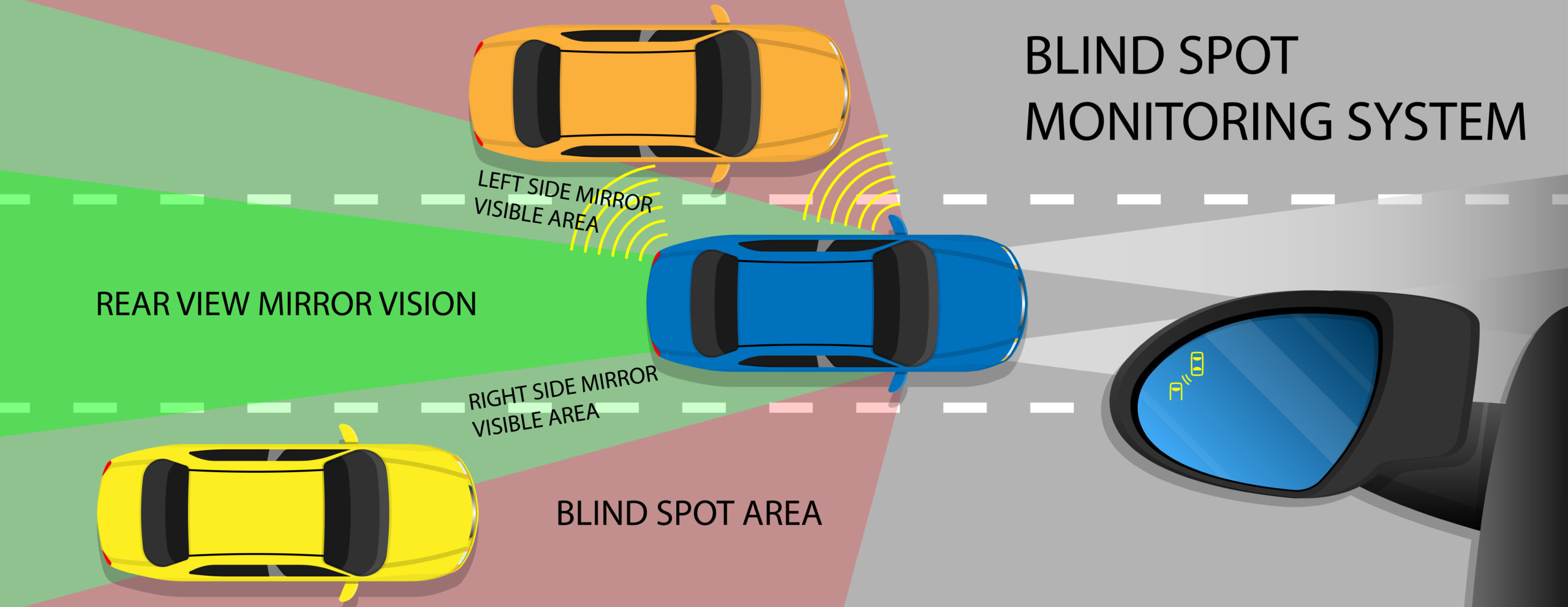
The best blind spot detection system is the one that will actually help you, and that you will use every time you drive. There’s no point throwing out stacks of cash on a fancy system if you will never use it.
You should choose a system depending on your vehicle and your preference, so here are some factors to consider to help you pick the right detection system for you.
Detection Range
This refers to the minimum and maximum distance between which an object can be detected. Having a broad detection range is important and depends on the size of your blind spot – the bigger the blind spot, the larger the detection range is needed.
Often this can be adjusted if you opt-in for a camera system, still making sure the view angle suits your vehicle.
Adjustable Indicators
Having the ability to adjust when a warning shows up is just as important as the detection range. This is particularly useful when the detection range is quite large, as you may only want a blind spot warning when an object is a certain distance away from your vehicle, and not as soon as it’s picked up by the sensor.
Also, changing the volume or brightness of warnings will make the time behind the wheel just safer and more pleasant.
Sensitivity and Reliability
An over-sensitive system can be as annoying, just as an under-sensitive system can be dangerous and pointless. The reliability of the detection system is linked to the sensitivity, as ultimately, you want to minimize the number of false positives while still being notified of all the false negatives.
To put this in some context – you don’t want to be warned of “something being close to your car” if it’s just a large leaf flying past, as this will be pointless, annoying, and desensitizing. But you do want to be notified of all the potentially dangerous situations, even if initially the object close to the vehicle seemed safe.
Installation
The nature of the installation is something to consider, which includes the difficulty of installation, the time required, the permanence of the system, as well as any special requirements particular to your vehicle.
If you’re after a permanent upgrade to your vehicle, OEM systems can be a great option and will fit your vehicle without much issue. If an OEM system is not available or you just want an aftermarket system, considering the installation requirements before your purchase is crucial to avoid wasting money and time.
| Product | Vehicle compatibility | Detection range | Type of warning | System type | Rating |
|---|---|---|---|---|---|
| Audiovox PSD100 | Any | 6 feet | Visual and audio signal | Ultrasonic/radar | 5 |
| RAAYOO Camera | Any | 170-degree view angle | Visual | Camera | 5 |
| Accele BSS200 | 14 feet | Audio and visual signal | Ultrasonic/radar | 4.5 | |
| Brandmotion RDBS-1500 | 2007-current | 15 feet | Audio and visual signal | Ultrasonic/radar | 4.5 |
| Rydeen BSS1 Blind Spot System | Any | 82 feet to the rear | Audio and visual signal | Microwave/radar | 4.5 |
| Natika Backup/Front/Side View Camera | Any | 135-degree view angle | Visual | Camera | 4.5 |
| E-KYLIN side camera | Any | 170-degree view angle | Visual | Camera | 4.5 |
| CarBest Ultrasonic Blind Spot Detection System | Any | 10 feet | Audio and visual signal | Ultrasonic/radar | 4.5 |
| BOYO VISION | Any | 8 feet | Audio and visual signal | Microwave/radar | 4.5 |
| EASYGUARD EBS001 | Any | 20-40 feet | Audio and visual signal | Microwave/radar | 4 |
| OttoNavi Blind Spot Monitor | Any | N/A | Audio and visual signal | Ultrasonic/radar | 3.5 |
Top 11 Best Blind Spot Systems 2025
1. Best Overall Pick: Audiovox PSD100
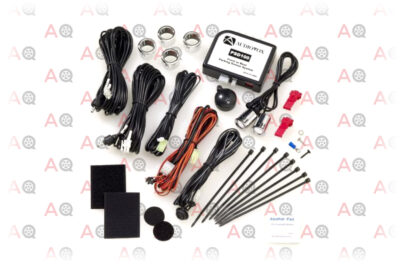
Editor’s Rating:
At a Glance:
- Vehicle compatibility: Any
- Detection range: 6 feet
- Type of warning: Visual and audio signal
- System type: Ultrasonic/radar
This blind spot detection system is a little fancier than the basic Accele BSS200. Not only does the system sport a low-key OEM look, but it is also upgradable if you so wish.
The advertised learning sensor is a built-in flash memory that can recognize mounted items and accessories such as spare tires. For this to work, the system needs to be trained as part of the installation. In the end, it’s a good extra safety net to have when trying to maneuver in a busy parking lot.
The two supplied sensors can be installed at the front or the back of the vehicle and will detect objects within a 6-foot radius. It has three zones of detection depending on how far the obstacle is – this is indicated with either red, yellow, or green LED signals. The auditory beep has an adjustable volume, and can also be muted.
Installation
Everything you need to install this system is included, however, the process takes quite a while due to the extra time required to train the system. All the connectors are waterproof, and the sensors have adjustable sensitivity, which is determined during the installation process.
Pros
- Can be installed either at the front or the back
- Waterproof connectors
- The sensors can ‘learn’
Cons
- Quite a short detection radius
- Not the easiest installation
2. Best Budget Pick: RAAYOO Camera

Editor’s Rating:
At a Glance:
- Vehicle compatibility: Any
- Detection range: 170-degree view angle
- Type of warning: Visual
- System type: Camera
For people who don’t want to be bothered by the beeps and flashes of a typical blind spot detection system, but still want to have improved awareness of what’s in their blind spot, a camera such as this one from RAAYOO is an option.
Specifically designed to keep an eye on the blind spot, it’s not your typical backup camera – the small size of this camera enables you to install it almost anywhere, either flush for the OEM look or on a bracket. With a 170-degree view angle and good night vision, you can always give the blind spot a glance on your LCD/TFT display.
Installation
This camera is completely customizable, depending on where you want to mount it and what you want to achieve. In the package, you get both a drill bit and mounting brackets with screws, which gives you an option whether you want it flush with the car body, or you want to mount it on the bracket, for example on your mirrors.
The camera wires can be cut to fit your needs – you can set up a mirrored view if mounting in the rear, or get rid of parking guidelines displayed on the screen if you don’t need them.
Pros
- Enables you to see the chosen blind spots
- Large viewing angle
- Can be installed flush or on external brackets
Cons
- No audio warnings
- Doesn’t inform you when something is in your blind spot
3. Best for Low Speeds: Accele BSS200

Editor’s Rating:
At a Glance:
- Detection range: 14 feet
- Type of warning: Audio and visual signal
- System type: Ultrasonic/radar
Similarly to other aftermarket blind spot detection systems such as the Brandmotion RDBS-1500 or the Audiovox PSD100, this one also has an OEM-friendly design to help you maintain your car’s aesthetic. In addition to some other models, this one has paintable sensors allowing you to match them to your car’s bumper color.
This system has both visual and audio warnings that come on when an obstacle is detected within 14 feet of the sensor. The sensors and connectors are waterproof, which increases the system’s longevity.
Installation
The system can only be installed on plastic bumpers and does require drilling them. Everything you need for the installation is supplied, but if you’re not comfortable pulling up your car, professional assistance may be preferred.
The sensors can be configured to be active when the turn signal is activated, or they can always be left on.
Pros
- Waterproof connectors
- Both audio and visual signals
- Good sensor range
Cons
- Not for metal bumpers
- Installation can be a little bit of a hassle
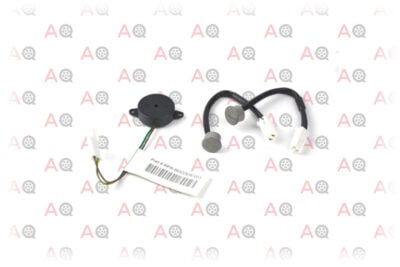
Editor’s Rating:
At a Glance:
- Vehicle compatibility: 2007-current
- Detection range: 15 feet
- Type of warning: Audio and visual signal
- System type: Ultrasonic/radar
The Brandmotion blind spot detection system is simple, yet good to have for the daily drive. Very minimalist in its design, it has an OEM-like finish, meaning it will blend in with your car and look as if it was always there.
As this detection system is essentially a radar, it will only work when in motion. In this case, a minimum of 15 mph is required making it more useful on the highway than in a parking lot.
The system has both audio and visual warning signals ensuring you won’t miss the warning and has a built-in night mode.
Installation
Everything you need is included in the box, which should provide for an easy installation. Wires do have to be pulled through the car, however, so some professional help is advised if you’re not comfortable drilling into your bumper and pulling up the carpets.
As in the case of pretty much any radar system, these sensors work with plastic bumpers only.
Pros
- Both audio and visual signal
- Separate mode for night and daytime
- Good detection range of up to 15 feet
Cons
- Not suitable for metallic bumpers
- Doesn’t detect objects below 15mph
5. Easiest to Install: Rydeen BSS1 Blind Spot System

Editor’s Rating:
At a Glance:
- Vehicle compatibility: Any
- Detection range: 82 feet to the rear
- Type of warning: Audio and visual signal
- System type: Microwave/radar
Like with other products in the category of microwave/radar technology, this one also results in a clean finish, and is most useful on the highway.
But unlike other options, this system offers two color options for the LED indicators in addition to an audible buzzer, which activates when an object is detected in your blind spot area.
As it is a radar system, it will detect when an object moves into your blind spot but won’t help with keeping track of objects that are following in your blind spot. Tied to this is the requirement to go at least 13 mph before the system activates. On the positive side, though, these sensors can detect and alert you to cross traffic when reversing.
Installation
If your bumpers are not metal, the installation of this system is easy enough. The sensors are installed under the bumper meaning no drilling is needed.
Pros
- No drilling required
- Large detection range to the rear
- Can detect cross traffic when in reverse
Cons
- Not for metal bumpers
- Minimum of 13 mph required for the system to work
6. Best Visual Blind Spot System: Natika Backup/Front/Side View Camera
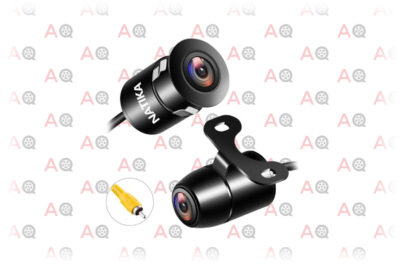
Editor’s Rating:
At a Glance:
- Vehicle compatibility: Any
- Detection range: 135-degree view angle
- Type of warning: Visual
- System type: Camera
Very similar in design to the RAAYOO Camera, this camera also can be mounted flush with the car or on the supplied bracket. However, the viewing angle is lower at 135 degrees.
Also, the camera has two switching loops, allowing you to have a mirrored or non-mirrored image, as well as the parking guidelines to be either on or off. As with other cameras, this does not have a warning signal when something comes into your blind spot, but you can keep an eye on this area at all times.
Installation
In the pack, you get one camera along with everything you need to install it – including zip ties and electric tape. The camera is waterproof and has good night vision so it can be used whatever the weather. You will need a screen in your car to plug this into, as one is not supplied in the pack.
Pros
- Everything needed for the installation is included
- Customizable view
- Decent view angle
Cons
- Needs a separate screen
- Only one camera included
7. Best Side Camera: E-KYLIN side camera
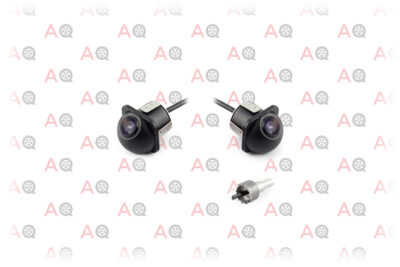
Editor’s Rating:
At a Glance:
- Vehicle compatibility: Any
- Detection range: 170-degree view angle
- Type of warning: Visual
- System type: Camera
Unlike the RAAYOO Camera, this one is specifically designed to mount onto your side mirrors, overall making it less customizable. Because of this specific design, it doesn’t sit flush with the car body, which may not be to everyone’s liking, but you do get supplied with two cameras in this set.
The view angle is a wide 170 degrees, and the camera is waterproof and works at night too. However, the image quality is still not the best. It’s sufficient to see if anything is in your blind spot but nothing to fawn over.
Installation
As the camera is designed to be mounted to the bottom of the side mirrors it’s angled in a way that doesn’t require an extra bracket like in the case of the offering from RAAYOO. Drilling is still required to fit the camera, and the drill bit is supplied, although it could have been of better quality.
Pros
- Specifically designed for side mirrors
- Two cameras included
- Wide view angle
Cons
- Not exactly an OEM look
- Drilling is still required
8. Best Value Blind Spot Detection System: CarBest Ultrasonic Blind Spot Detection System

Editor’s Rating:
At a Glance:
- Vehicle compatibility: Any
- Detection range: 10 feet
- Type of warning: Audio and visual signal
- System type: Ultrasonic/radar
Much like other blind spot detection systems, this one has an OEM look and warns when a car enters your blind spot. In addition to LED warnings, the buzzers also go off but only when your turn signal is active, making it an ideal assistant when changing lanes on the highway.
With 10 foot detection range to the sides and an 80-degree detection angle, it’s a worthy competitor to the Brandmotion RDBS-1500 and the Audiovox PSD100.
Installation
Just like other systems on the market, this one is also easy enough to install if you know your car well. Drilling is required to fit the sensors, which can also be painted afterward for a seamless look.
When installed correctly, the system can also be used to assist in reversing by giving off a warning when approaching an obstacle.
Pros
- Paintable OEM style sensors
- Great assistance on the highway with the range of detection
- Can be used as reverse assist
Cons
- No mention of volume control
9. BOYO VISION

Editor’s Rating:
At a Glance:
- Vehicle compatibility: Any
- Detection range:8 feet
- Type of warning: Audio and visual signal
- System type: Microwave/radar
Similarly to the Easyguard EBS001 these sensors are also based on the microwave/radar technology. The supplied sensors have a 9.8 foot detection range to the sides of the vehicle, which is sufficient to be useful on the highway.
When an object is detected by the sensors in your blind spot, a visual warning will flash along with an audible buzz, which also applies to cross traffic when reversing.
Installation
The sensors are designed to be installed under the bumper, resulting in a neat and invisible result that doesn’t require any drilling. Unfortunately, as with most systems, plastic bumpers are required to install this system. But if you still want to use it with your metal bumpers, then an external housing and mount are required.
Pros
- Invisible installation
- Can detect cross traffic
- Sufficient range of detection
Cons
- Will not work with metal bumpers
- Expensive
10. EASYGUARD EBS001
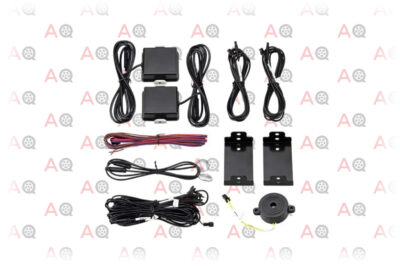
Editor’s Rating:
At a Glance:
- Vehicle compatibility: Any
- Detection range: 20-40 feet
- Type of warning: Audio and visual signal
- System type: Microwave/radar
The Easyguard detection system utilizes microwave radar sensors that are installed under the bumper. The LED indicators, as well as the buzzer, will alert you when an object moves into your blind spot, informing you when lane changing of the upcoming hazard.
The system has a great range of up to 40 feet to the rear and 20 feet to the side, meaning it can constantly monitor the neighboring lanes. With the speed monitoring accuracy of 0.5m/second, it will be able to alert you of a vehicle that is in your blind spot, even if it’s going close to your speed.
However, this detection system doesn’t work while reversing, meaning it is unable to detect moving cars in parking lots.
Installation
The two supplied microwave sensors are installed under the rear bumper, meaning you won’t need to drill any holes in your car. However, this also means that it can only be installed under a plastic bumper – not a metal one.
Pros
- No drilling required
- Large detection range
- Completely hidden away on the outside of the car
Cons
- Doesn’t work for reversing
- No volume controls
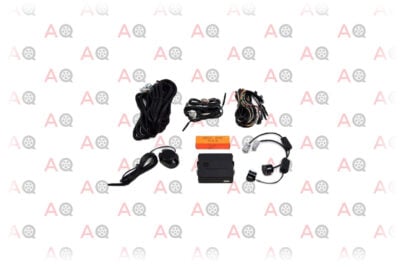
Editor’s Rating:
At a Glance:
- Vehicle compatibility: Any
- Detection range: N/A
- Type of warning: Audio and visual signal
- System type: Ultrasonic/radar
The OttoNavi blind spot detection system monitors the blind spot areas and can assist with changing lanes by detecting upcoming vehicles. The obstacle detection warning is both visual and auditory, with the ability to change the volume of the beep or turn it off completely.
The sensors are paintable and waterproof, just like the Accele BSS200, and have an OEM-like look as they sit flush with the bumper. However, the sensors will not work with cars that use the brake light as the turn signal light.
Unfortunately, the manufacturer doesn’t disclose the detection range of the sensors, and this lack of a boast suggests quite a short range. In turn, a short detection range means this system isn’t reliable at high speeds on the freeway but will do well in a parking lot and tight spaces. The sensors are basic, unlike the Audiovox PSD100 learning system, and detect objects other than cars.
Installation
The installation of this system isn’t more invasive than other OEM style systems – you will need to drill into your bumper and pass the cables under the carpets, and car trims inside. However, OttoNavi has made a YouTube video on how to install these blind spots sensors.
Pros
- Waterproof
- Sensors can be painted
- Will fit any car
Cons
- Detects objects other than cars
- Not reliable at high speeds
Ultimate Buyers Guide to the Best Blind Spot Detection Systems
Before you decide what blind spot detection system is best for your vehicle and your needs, learning a little bit about the technologies and jargon used in this field will assist you greatly with choosing well.
Types of Blind Spot Detection Systems
The market of blind-spot detection systems (BSDs) is a little niche and confusing with a lot of tech-jargon being thrown around. Here we will try to shed some light and clarify this field, explaining some of the technology behind these systems.
Factory Installed BSDs
In newer cars, blind spot detection systems (BSD) are installed by design, resulting in an intentional finish rather than looking like an odd DIY job. Not only are these aesthetically more pleasing, but they are simply better than the universal aftermarket systems.
As manufacturers have their own proprietary BSD systems, these are calibrated to the specific model of the car, giving you the best accuracy and reliability. Along with that car manufacturers tend to also use a “proprietary name” for the equipment, so here are some blind spot monitoring system names according to car manufacturers:
- Audi: Audi Side Assist
- BMW: Active Blind Spot Detection
- Mercedes-Benz: Blind Spot Assist, Active Blind Spot Assist
- Volkswagen: Blind Spot Monitor
- Volvo: Blind Spot Information System
- Honda and Acura: Blind Spot Information System
- Nissan and Infiniti: Blind Spot Warning
- Toyota and Lexus: Blind Spot Monitor
OEM
The Original Equipment Manufacturer (OEM) is a company that manufactures equipment that is marketed and used by other companies. In the case of BSDs, it means that the factory-installed system in a car is produced by a different company to the car manufacturer. The company which does the manufacturing of the system can then sell those same products to anyone on the market, not just the car manufacturer.
Some aftermarket systems try to mimic the OEM systems, but they tend to go only as far as achieving the right aesthetic look, but not the reliability or accuracy. It can be quite difficult to verify if the system you wish to purchase is OEM or look-alike.
Aftermarket
Anything that is not factory-installed is classed as an aftermarket installation. If you want to upgrade your car to have a BSD system you can either try to search for an OEM part for your specific vehicle model, or you can go for a universal system, like the ones presented in this article, that will fit almost any car.
Although the universal systems will fit any vehicle, some corners need to be cut, which comes at a cost to the accuracy and reliability of the equipment. They’re still a great option if you’re on a budget and still want to improve safety while driving.
Microwave vs. Ultrasonic
The ultrasonic detection systems are now considered to be the older technology, being slowly replaced by microwave systems.
Ultrasonic
Ultrasonic systems are based on the “line of sight” where a beam is emitted from the sensor in order to scan for obstacles. As the beam bounces back from an object, the sensor picks up this signal and determines how far the object is based on the time it took for the emitted beam to come back. Once the signal is detected and is within the programmed range, you get an alert in the form of an LED flash or a buzz.
These systems require drilling into your bumper and are less accurate than the newer microwave technology. However, the ultrasonic systems are still used by car manufacturers and OEMs as they can be precisely calibrated and programmed to the specific car model resulting in very good reliability and accuracy.
Microwave
As universal aftermarket systems can’t program their systems to any specific vehicle, the newer microwave technology is becoming more commonly used. Since microwave systems are not based on the “line of sight” principle like the ultrasonic sensors are, they can be mounted behind the bumper for a clean, drill-free, finish.
Not only do these systems look better aesthetically but also they perform better with less false alarms and improved accuracy.
Radar vs Sonar
Radio detection and ranging (radar), and sound navigation and ranging (sonar) are two different ways of object detection.
Sonar systems rely on sound waves to detect objects, while radar systems rely on radio waves instead. Sonar tends to be used by submarines to map the bottom of the sea and avoid collisions, while radar is more often used to detect fast-moving objects.
This means that a typical reverse parking aid will most likely use a sonar system, while a typical blind spot detection system will use a radar-based system. Although radar can be used for mapping of static objects, most of the BSD systems utilize radar specifically to calculate the speed the potential hazard is going at, which in turn means poor accuracy when either you or the hazard is stationary.
Blind Spots in the Car
Vehicles tend to have two major blind spot areas found to the rear and the sides. However, there is one other category, often forgotten, which is the blind spots created by the car pillars. Depending on the size and shape of the vehicle, mirror adjustments, and even the driver’s height, the blind spot areas can greatly vary in size.
Rear
Also known as cross-traffic blind spot, this is the area to the vehicle’s rear left and rear right. Depending on your rear and side mirror adjustments, both left and right blind spots can be present, or just one of them.
These blind spots can lead to close calls and collisions when backing out, being unable to see an oncoming vehicle. A good rearview camera system such as the RAAYOO will eliminate these blind spots, as you will be able to see what’s happening back there without having obstructions in your line of sight.
Sides
These are by far the biggest and most dangerous blind spot areas, one on the right and one on the left of the vehicle. To check these blind spots, you can’t rely on mirrors alone, and you have to make a head check before doing a maneuver to make sure nothing is there.
Ever had a motorcyclist quickly zoom past you as they overtake? Most likely (there are some rude cases) it’s because they just don’t want to hang out in your blind spot and risk being driven into! Cyclists are also at risk of not being seen and should prefer to not hang in your blind spot.
Any time you decide to do a lateral maneuver – changing lanes, overtaking, making a turn – your side blind spot becomes extremely dangerous to other road users, and you should make sure you’re not putting anyone at risk by turning your head to check that blind spot.
Newer cars will have blind spot detection systems built in to check these side blind spots, however, older cars have to equip themselves with aftermarket upgrades. Something as simple as a convex mirror can help you see in your blind spot and keep you safer.
There are also some OEM style sensor systems you can install such as the Brandmotion RDBS-1500. Regardless – nothing should ever replace a physical head check, at least not for now.
Pillars
These refer to the window support posts in your car, of which you have three sets – windshield pillars (A-pillars), passenger pillars (B-pillars), and rear window pillars (C-pillars). The A-pillar blind spot can lead to some unexpected close calls and collisions, particularly with pedestrians, on roundabouts, intersections, and crossings.
The pillar blind spots get larger with distance – something that’s further away is more likely to be in these blind spots than something up close. The B- and C-pillar blind spots can be eliminated with side and rear camera systems. However, the A-pillar blind spot is best avoided by simply looking out and checking if anything is there before doing a maneuver.
Special Blind Spot Cases
Not every vehicle has the same blind spots. Here are some extreme cases that require special consideration.
Large Vehicles – Trucks/RVs
For anything larger than a sedan, extra sensors and cameras can really positively impact your driving experience. The larger the vehicle, the bigger the blind spots, often with areas you simply cannot see, even if you do a head check.
To improve your safety and the safety of others around you, installing some form of a blind spot monitoring system to the areas you cannot see is the best option. Whether it’s a camera like the Natika installed to the front or rear bumper, or a radar system like the Audiovox PSD100, anything that will help you be aware of other road users will greatly reduce the chances of a collision.
Motorcycles
If you’re a crazy person who rides around with no side mirrors, then even a camera system such as the RAAYOO Camera installed in the back of your motorcycle isn’t a good idea or a good replacement for your mirrors. In such cases, if you want to be safer on the road, just putting the side mirrors back on is the simplest way to see what’s happening behind you.
If you do use side mirrors but want an additional system to help you see the blind spot, instead of investing in one of the above expensive systems installing a convex mirror, such as the Ampper Mirror, instead would be sufficient. After all, nothing will be easier than to just turn your head to check your blind spot.
Final Thoughts
Regardless of your experience level, a blind spot detection system will make your life on the road easier and safer by presenting you with extra information about your surroundings that can sometimes be critical to avoiding a collision.
Since the benefits are obvious, most car manufacturers are moving towards models with blind-spot detection integrated into the design. But if your car doesn’t already have such a system you should definitely consider one of the products above.
